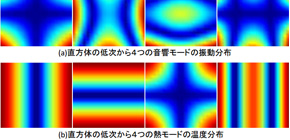
Discovery of features that heat conduction shares with acoustic resonance
Will enable measurements of thermal conductivity of very small specimens and improvement of heat-exchange efficiency
A group of researchers led by Associate Professor OGI Hirotsugu and Assistant Professor ISHIDA Hideshi succeeded in observing unique modes of thermal diffusivity (thermal modes) of solids, a world first. This group found that there are various thermal modes in heat conduction as is the case with resonance, which has various resonance modes (acoustic modes), and that each mode has its own frequency and vibrational distribution.
A thermal mode has its own temperature distribution: the antinode of the thermal mode, where a large temperature change occurs, and the node of the thermal mode, where the minimum temperature change occurs. When solids are heated quickly, various thermal modes are excited and the temperature change starts at a speed specific to each mode. Because of various thermal modes with different temperature distributions and temperature change rates, temperature seems to rise evenly at a constant rate.
This group found that local heating excited thermal diffusivity because of various thermal modes, and that they had only to heat the antinode of the desired thermal mode and detect the specific temperature of that antinode in order to excite a desired thermal mode selectively.
It is possible to correctly measure thermal conductivity of millimeter-size solids by using the thermal mode. Once the thermal mode is excited by heat, temperature change starts to occur toward the equilibrium temperature, but the relaxation time for equilibrium is specific to each mode. The relaxation time is closely related to thermal conductivity of solids, so thermal conductivity can be available by measuring the relaxation time. (The relaxation time is inversely proportional to thermal conductivity.)
It is thought that the use of thermal modes will make it possible to measure material which has high thermal conductivity and whose size is difficult to grow and contribute to the development of materials with high thermal conductivity. Furthermore, by performing heating, cooling, and thermal exchange in view of the thermal mode of solids, it will become possible to increase the efficiency of heating and other processes.
This group’s achievement demonstrated that the thermal mode is academically and practically important because it governs heat conduction. The thermal mode is comparable to acoustic resonance and they have many features in common. It is hoped that applications using characteristics of thermal modes will also be generated.
Abstract
Heat conduction possesses (thermal) modes in analogy with acoustics even without oscillation. Here, we establish thermal mode spectroscopy to measure the thermal diffusivity of small specimens. Local heating with a light pulse excites such modes that show antinodes at the heating point, and photothermal detection at another antinode spot allows measuring relaxation behavior of the desired mode selectively: The relaxation time yields thermal diffusivity. The Ritz method is proposed for arbitrary geometry specimens. This method is applicable even to a diamond crystal with ∼ 1 mm dimensions.
Figure 1
Figure 2
Figure 3
Figure 4
To learn more about this research, please view the full research report entitled “ Thermal Mode Spectroscopy for Thermal Diffusivity of Millimeter-Size Solids ” at this page of the Physical Review Letters website.
Related links
